Towards an industrial architecture: The influence of the 1956 article But today we collect ads on Alison and Peter Smithson's postwar domestic architecture
DOI:
https://doi.org/10.64197/REIA.25.984Keywords:
Arquitectura, IndustrializaciónAbstract
Ablinger works are played with many different formats, including concerts, installations, performances, operas for natural and urban environments, conceptual music, etc. In June 1955, architects Alison and Peter Smithson wrote a first draft of what a few months later, in November 1956 and in issue 18 of ARK magazine, would become their famous article But Today we Collect Ads. Understood by many authors as a manifesto in favor of a new pop architecture, indebted to the recent fascination of the world of culture with post-war consumer objects, But Today we Collect Ads was to be, however, the first plea made by the Smithson in favor of a truly industrialized architecture. Thus, this article, which complements its text with the publication of the original typescripts of the article, seeks not only to emphasize its importance in the work of its authors, but also to bring to debate the widely assumed certainty that the Modern Movement was a profoundly industrialized movement.
Downloads
Downloads
Published
How to Cite
Issue
Section
License
Copyright (c) 2024 Jaime Sanz Haro, Alexander Díaz Chyla

This work is licensed under a Creative Commons Attribution 4.0 International License.





